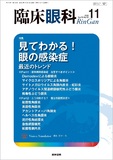Japanese
English
- 有料閲覧
- Abstract 文献概要
- 1ページ目 Look Inside
- 参考文献 Reference
要約 目的:近年,角膜診療に人工知能(AI)を導入する試みが進行している。今回筆者らは,AIによる疾患の自動分類のなかで「非感染性角膜浸潤」に着目し,周辺部角膜疾患が実際どのように分類されるのか,さらにその分類に眼球結膜充血の程度が及ぼす影響について検討した。
対象と方法:2023年9月までの過去10年間に広島大学病院を受診し,周辺部角膜潰瘍の診断がついた27症例の前眼部写真70枚を角膜AI診断支援ソフト(プロトタイプ:CorneAI)に適用した。また,「アレルギー性結膜疾患診療ガイドライン(第3版)」の眼球結膜の充血の程度分類を参考に,「軽度(充血なしも含む)」「中等度」「高度」の順位尺度で3段階に分類し,AIで正常と分類された写真と何らかの異常ありと分類された写真(以下,異常群)における充血の比較を行った。
結果:角膜浸潤を伴う急性期の写真25枚に対して,AIが「非感染性角膜浸潤」と正答した写真が15枚(60%)であり,誤分類10枚の内訳は正常2枚,感染性角膜浸潤6枚,腫瘍2枚であった。一方,寛解期から鎮静期にかけての写真45枚に対するAI分類は,「非感染性角膜浸潤」もしくは「瘢痕」と正答した写真が23枚(51%),誤分類22枚の内訳は正常18枚,沈着1枚,腫瘍1枚,水晶体混濁2枚であった。全70枚中,正常と誤分類された20枚の充血分類は軽度16枚,中等度4枚,異常群に分類された50枚の充血分類は軽度17枚,中等度24枚,高度9枚であり,異常群では正常と分類された群よりも有意に充血が強かった。
結論:周辺部角膜疾患は,治癒過程で炎症が抑えられている場合に正常もしくは別の疾患に分類されることがあり,CorneAIによる自動分類には充血の程度が影響を与えていると考えられる。
Abstract Purpose:Recently, efforts to introduce artificial intelligence(AI) into corneal diagnosis have been advancing. In this study, we focused on “non-infectious corneal infiltrates” in AI automatic classification and examined how peripheral corneal diseases are classified and the influence of bulbar conjunctival hyperemia on this classification.
Subjects and methods:We used 70 anterior segment photographs from 27 patients diagnosed with peripheral corneal ulcers who visited Hiroshima University Hospital during the ten years period up to September 2023 for the development of the corneal AI diagnostic support software(prototype software CorneAI). Additionally, referring to the conjunctival hyperemia grading system from the Allergic Conjunctival Disease Clinical Practice Guidelines(3rd ed), we classified the cases into three ordinal scales:“mild(including no hyperemia),” “moderate,” and “severe,” and compared hyperemia between photographs classified as normal by AI and those classified as abnormal(abnormal group).
Results:Out of the 25 photographs in the acute phase with corneal infiltrates, AI correctly classified 15 photographs(60%) as “non-infectious corneal infiltrates,” while ten misclassifications included two as normal, six as infectious corneal infiltrates, and two as tumors. On the other hand, of the 45 photographs from the remission to quiescent phases, AI correctly classified 23 photographs(51%) as “non-infectious corneal infiltrates” or “scarring,” while misclassifications included 18 as normal, one as deposits, one as a tumor, and two as lens opacity. Among the 70 photographs, the hyperemia classification of the 20 photographs misclassified as normal showed 16 with mild and four with moderate hyperemia, whereas the abnormal group of 50 photographs showed 17 with mild, 24 with moderate, and nine with severe hyperemia, indicating significantly stronger hyperemia in the abnormal group than in the normal group.
Conclusion:Cases may be classified as normal or as different diseases when inflammation is suppressed during the healing process. The degree of hyperemia is believed to influence automatic classification by the CorneAI.

Copyright © 2025, Igaku-Shoin Ltd. All rights reserved.


